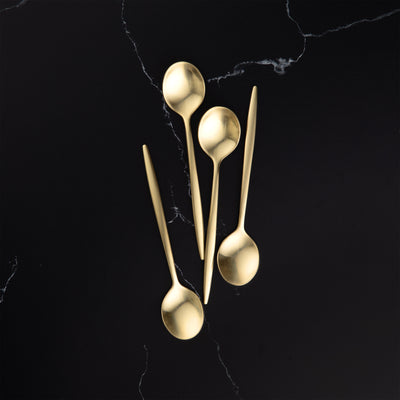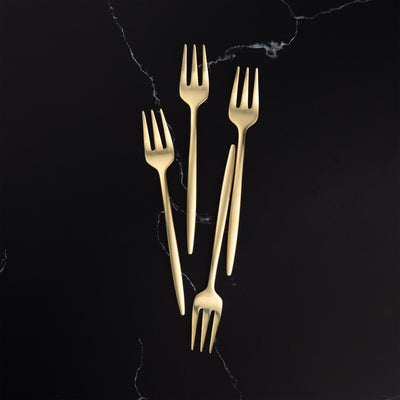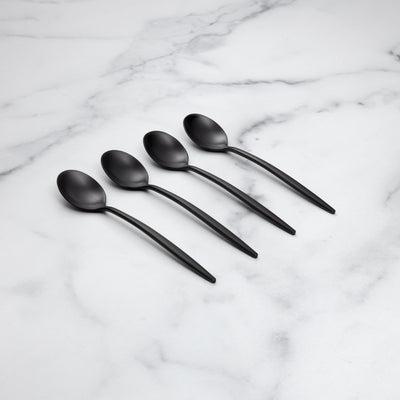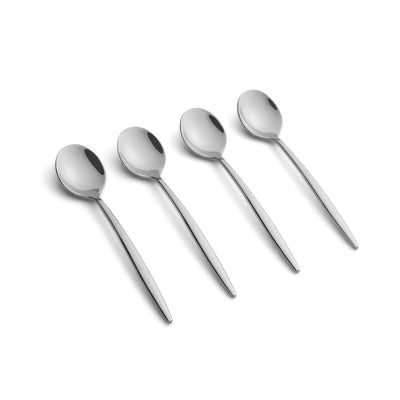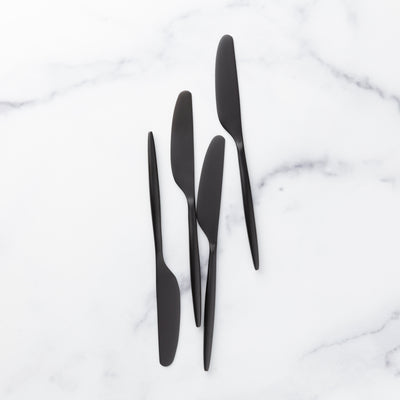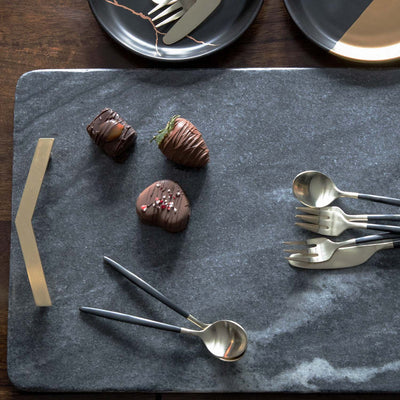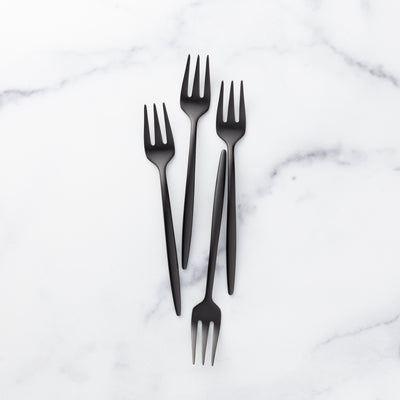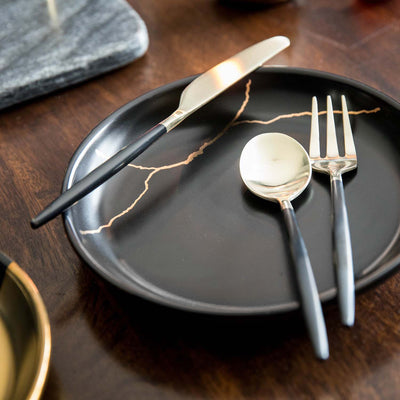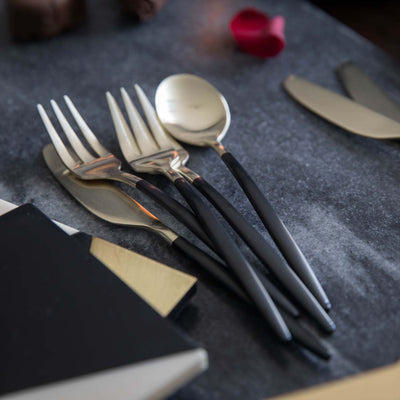Product Care and Use: Flatware
Stainless steel flatware is dishwasher safe and easy to maintain. Caring for your utensils properly helps preserve their luster and longevity for years to come. Follow the flatware care instructions below for optimal use and maintenance:
- Wash flatware thoroughly before the first use.
- Do not let food remnants remain on your flatware for prolonged periods. Remove food soil immediately, as some foods are harsh to stainless steel and can cause pitting. This includes vinegar, salt, mustard, mayonnaise, and more.
- Avoid soaking your flatware for prolonged periods before washing. If food remnants are difficult to remove, let your utensils sit in warm water with mild detergent for no more than 10 minutes, and avoid soaking with aluminum or copper materials. Soaking too long can lead to stains, corrosion, or a filmy buildup on your utensils.
- Use chloride and chlorine-free solutions for cleaning.
It’s important to remember that stainless steel is stain resistant but not stain proof. If subjected to unfavorable conditions, it can corrode and tarnish.
Washing Your Flatware
Properly washing your flatware is one of the best ways to prolong its lifespan. Cambridge® flatware is dishwasher safe and can also be washed by hand.
Whether cleaning stainless steel flatware by hand or with a dishwasher, you should avoid washing it alongside aluminum or copper items. You should also never use dish detergent that contains harsh chemicals, a lemon scent, bleach, or chlorides.
Dishwashing
If you are using a dishwasher, there are some guidelines to follow to ensure the safety of your flatware. You should always load forks and spoons with their handles down and avoid “nesting.” Place knives in a separate section with blades pointed down to prevent contact with other metals and potential scratching. It’s best to use a dishwasher-safe flatware basket that separates each piece, especially when dishwashing your plated, chromium, or titanium coated products.
Cambridge® recommends Cascade Complete Gel Packs for dishwashing flatware products, as they have additives that help control the pH level of the water. It’s important to follow your dishwasher manufacturer’s instructions to determine the appropriate amount of detergent to use. This is particularly helpful if you have hard or soft water. If you use too little detergent in hard water, your dishwashing process will not be as effective. Meanwhile, if you use too much detergent in soft water, your flatware can rust or etch.
Washing by Hand
When washing flatware by hand, use hot water and mild detergent – Dawn is ideal. Avoid using metal scrub brushes, scrapers, or steel wool, and do not use the scouring or abrasive side of your sponge. This can lead to scratches and increases the risk of corrosion.
Drying and Storing Your Flatware
When washing your flatware in the dishwasher, it’s best to use a rinse aid to help remove water and reduce the drying time, which prevents spots and streaks. If you are hand-washing your Cambridge® products, you should always avoid air-drying. Instead, use a soft cloth to remove moisture from your flatware and store it in a dry place until you’re ready to use it again.
All flatware should be stored in a dry place (such as a drawer) until you’re ready to use it again.
Polishing Your Flatware
When cared for properly, Cambridge® flatware should never need polishing. However, if hard water stains, mineral buildup, water spots, or detergent stains appear on your utensils, you can use the following guidelines for polishing:
- Wipe the flatware down with a cloth dipped in vinegar until stains disappear.
- Once the stains are gone, clean each piece to remove the vinegar. This should brighten your flatware and bring its luster back.
- Occasionally, you may choose to use a polish to remove film buildup or staining. Make sure to use polish specifically made for stainless steel.
- Once polished, rinse thoroughly. Do not use stainless steel polish on flatware that is plated or coated.
- Brushed or satin-finished products can be polished with Scotch-Brite pads. Simply place the utensil between a folded pad and gently move it up and down along the length of the item.
Caring for Cambridge® Knives
Knife blades are sensitive to acidic foods, soaking, and air drying. Therefore, it’s important to wash your knives promptly after use and dry them immediately. Avoid storing them in plastic or other wrappings that can trap moisture. You should also keep knives and other hollow-handle flatware away from open flames and other sources of extreme heat. Do not try to sharpen knives that have serrated edges, as this could result in damage to the blade.
Physical Vapor Deposition Flatware Care
Products coated with PVD are easy to care for and can be cleaned in the same way as uncoated stainless steel because the color itself is a hard coating. You should avoid using abrasive pads, such as Scotch-Brite or Brillo pads. These can cause scratching and potentially remove the PVD layer. Additionally, it’s crucial to prevent item-to-item contact in the dishwasher or when handling flatware to minimize the risk of scratches and premature wear.
Product Care and Use: Barware
Wondering how to get your bar glasses clean? Some Cambridge® tumblers, mugs, and bar accessories are top-rack dishwasher safe, while other items are hand-wash only. When cleaning barware, wash all products promptly after each use with a gentle, non-abrasive dish detergent. For more barware care information, please refer to the product label and the specific product detail page.
Washing Dishwasher-Safe Barware
Products noted as dishwasher-safe barware should be placed in the top rack of your dishwasher. Avoid cleaning stainless steel pieces in the same load as those made from other metals like aluminum. You should also ensure that your barware products are not touching each other in the dishwasher to avoid scratches and premature wear.
Washing Barware by Hand
Barware noted as hand-wash only should be washed with warm, soapy water, then dried immediately with a soft, clean towel. Use a mild detergent and gentle sponge to avoid scratching the product.
Caring for Shakers, Ice Buckets and Insulated Drinkware
Dishwasher-safe products can be placed in the top rack of your dishwasher. Avoid washing stainless steel items in the same load as those made from other metals like aluminum. Keep products from touching each other in the dishwasher to avoid scratches and premature wear.
Barware noted as hand-wash only should be washed with warm soapy water, then dried immediately with a soft, clean towel. Do not soak insulated drinkware in water.
Caring for Ice Buckets
It’s important to clean and dry your ice bucket after every use to avoid bacterial growth. For ice buckets that are hand-wash only, thoroughly scrub the entire bucket, including the interior where the bottom meets the sides. Dry the product immediately after washing.
Using and Caring for Glass Barware
Never use glass items that are visibly damaged, scratched, chipped, or cracked, as they can be a safety hazard. You should also avoid hard impacts and sudden, drastic temperature changes (such as pouring a boiling liquid over ice inside glass barware) – both of which can cause breakage.
Dishwasher-safe barware can be placed in the top rack of the dishwasher. Avoid cleaning stainless steel products in the same load as products made with other metals such as aluminum. Separate your barware pieces in the dishwasher to avoid breakage, scratches, and premature wear.
Etching can occur on glassware due to soft water, high temperatures, or too much dish detergent. To avoid this issue, reduce the amount of dishwasher detergent used (but be sure to use at least one tablespoon), keep the water temperature no higher than 140 degrees, and load fewer items into the dishwasher at a time to ensure thorough rinsing.
To hand-wash glassware, use a non-scratch pad and gentle detergent.
Microwave and Oven Safety
The majority of our products are made with stainless steel and should not be placed in the microwave or oven.

